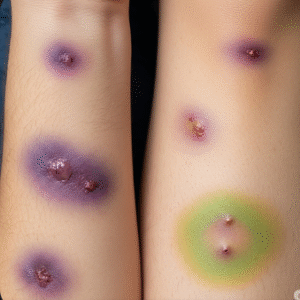What it is
The Total Iron-Binding Capacity (TIBC) and transferrin test is a blood test that measures the blood’s ability to transport iron.
➡ Key facts:
- TIBC evaluates the maximum amount of iron that blood proteins, mainly transferrin, can carry
- Transferrin is a protein that binds and transports iron to tissues, including the bone marrow for red blood cell production
- The test helps assess iron status, diagnose anemia, and monitor iron therapy
- Available in hospitals, diagnostic labs, and specialized pathology centers throughout Korea
💡 Measuring TIBC and transferrin provides crucial information about iron metabolism and overall hematologic health.
Why it’s done
Doctors recommend TIBC and transferrin tests for:
➤ Diagnosing anemia → Differentiates between iron deficiency anemia and anemia of chronic disease
➤ Monitoring iron therapy → Evaluates response to supplementation
➤ Detecting iron overload → Conditions like hemochromatosis
➤ Assessing nutritional status → Malnutrition or chronic illness affecting iron metabolism
➤ Guiding clinical decisions → Helps plan transfusions or supplementation
⚠ Without these tests, iron-related disorders may go undetected, leading to complications like fatigue, organ damage, or impaired immunity.
Alternatives / Complementary Measures
Other tests and measures for evaluating iron status include:
✔ Serum ferritin → Measures stored iron levels
✔ Serum iron → Detects circulating iron in the bloodstream
✔ Hemoglobin and hematocrit → General blood counts for anemia detection
✔ Reticulocyte count → Evaluates bone marrow activity
✔ Liver function tests → In cases of suspected hemochromatosis
⚠ While these tests provide complementary information, TIBC and transferrin remain essential for a full picture of iron transport and availability.
Preparation
Before a TIBC and transferrin test in Korea:
🔹 Fasting → Usually not required, but some labs recommend fasting for 8–12 hours
🔹 Medication review → Iron supplements or medications affecting iron metabolism may need to be paused
🔹 Hydration → Adequate water intake for easier blood collection
🔹 Medical history → Inform doctor of liver disease, pregnancy, chronic illnesses, or recent blood transfusions
💡 Korean diagnostic labs provide pre-test instructions and counseling to ensure accurate results.
How it’s done
➡ Step-by-step procedure:
- Blood draw → Sample taken from a vein in the arm
- Lab analysis → Measures:
- TIBC → Maximum iron that can be bound by transferrin
- Transferrin levels → Concentration of the iron-transport protein
- Transferrin saturation → Percentage of transferrin bound to iron
- Result interpretation → Compared with reference ranges to detect iron deficiency or overload
💡 The test is quick, minimally invasive, and safe, taking only a few minutes for sample collection.
Effectiveness & Accuracy
✔ Highly reliable for evaluating iron-binding capacity and transport
✔ Sensitive for detecting early iron deficiency before anemia develops
✔ Combined tests (TIBC, transferrin, ferritin, and serum iron) increase diagnostic accuracy
✔ Regular monitoring → Helps track treatment effectiveness in iron supplementation or chronic disease management
💡 Korean labs use advanced automated analyzers ensuring accurate, consistent results with rapid turnaround.
Recovery / Expected Outcomes
✔ Immediate recovery → Most patients can resume normal activities immediately after blood draw
✔ Minimal discomfort → Slight pain or bruising at the puncture site may occur
✔ Follow-up → Doctor reviews results and recommends:
- Iron supplements if deficiency detected
- Further testing for underlying causes
- Lifestyle or dietary changes to improve iron status
💡 Results provide valuable insights for anemia management, nutrition planning, and chronic disease monitoring.
Complications / Risks
⚠ TIBC and transferrin tests are very safe, but minor risks include:
➡ Bruising at the blood draw site
➡ Mild discomfort or dizziness
➡ Inaccurate results if iron supplements or recent transfusions are not disclosed
➡ Rare infection at the puncture site
💡 Korean labs follow strict sterile protocols to minimize complications.
Treatment Options in Korea (After Testing)
🔹 Iron deficiency treatment: Oral or intravenous iron supplementation
🔹 Dietary adjustments: Iron-rich foods (meat, fish, leafy greens) and vitamin C for absorption
🔹 Management of iron overload: Phlebotomy, chelation therapy, or dietary modification
🔹 Monitoring: Repeat TIBC, transferrin, and ferritin tests to track progress
🔹 Specialist consultation: Hematologist or nutritionist for complex cases
💡 Korean healthcare emphasizes personalized treatment plans based on lab results and patient health status.
Top Hospitals & Labs in Korea for TIBC and Transferrin Testing
🏥 Seoul National University Hospital (SNUH) – Comprehensive hematology and lab services
🏥 Asan Medical Center (Seoul) – Advanced diagnostics and iron metabolism assessment
🏥 Samsung Medical Center (Seoul) – Offers rapid TIBC and transferrin testing with full clinical support
🏥 Major private diagnostic laboratories – Accessible nationwide with same-day reporting options
🏥 Specialized nutrition and hematology centers – Integrated lab testing with personalized care
Conclusion
The TIBC and transferrin test in Korea is a critical diagnostic tool for evaluating iron metabolism, detecting anemia, and guiding treatment.
✔ Quick, safe, and minimally invasive procedure
✔ Provides essential information about iron transport and availability
✔ Helps diagnose deficiency, overload, or chronic conditions early
✔ Korean hospitals and labs ensure high accuracy, fast reporting, and comprehensive post-test guidance
By offering advanced testing, accurate interpretation, and integrated follow-up care, Korea ensures patients can effectively manage iron-related disorders and maintain optimal hematologic health.













